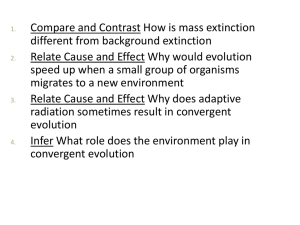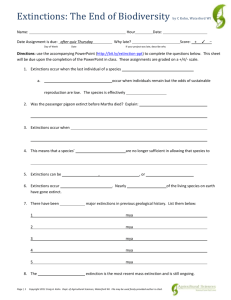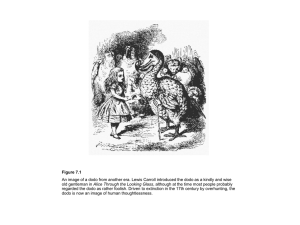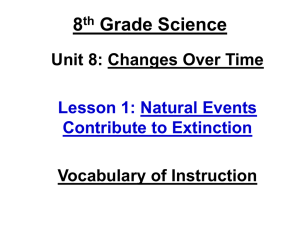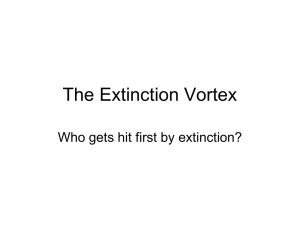extinction_exercise
advertisement
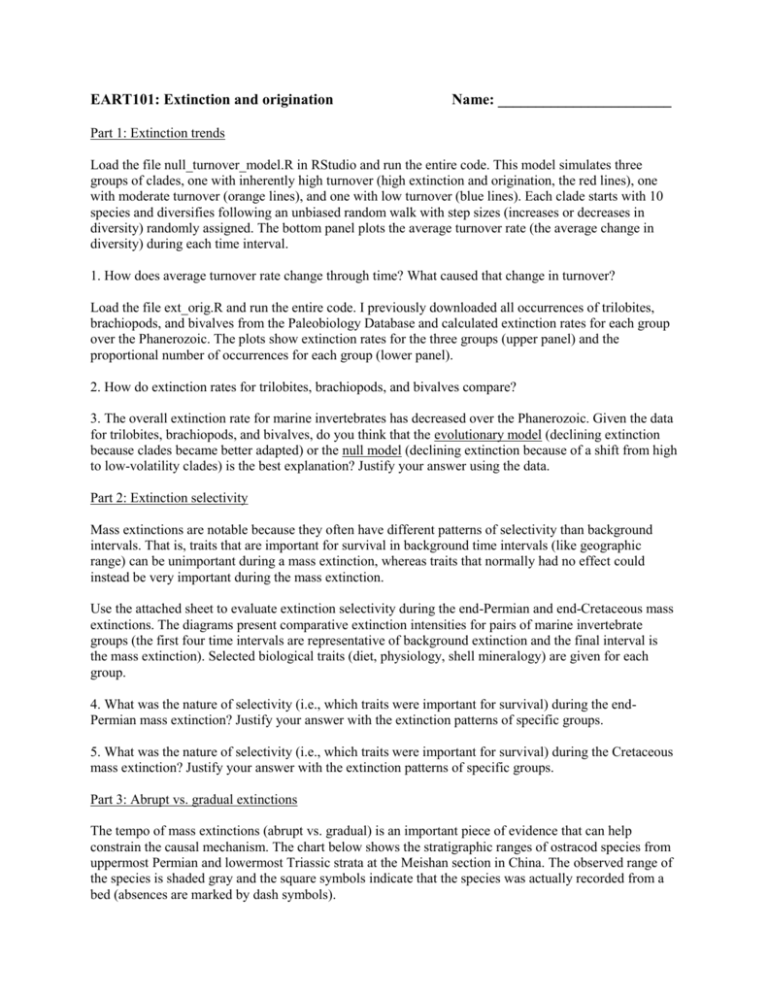
EART101: Extinction and origination Name: _______________________ Part 1: Extinction trends Load the file null_turnover_model.R in RStudio and run the entire code. This model simulates three groups of clades, one with inherently high turnover (high extinction and origination, the red lines), one with moderate turnover (orange lines), and one with low turnover (blue lines). Each clade starts with 10 species and diversifies following an unbiased random walk with step sizes (increases or decreases in diversity) randomly assigned. The bottom panel plots the average turnover rate (the average change in diversity) during each time interval. 1. How does average turnover rate change through time? What caused that change in turnover? Load the file ext_orig.R and run the entire code. I previously downloaded all occurrences of trilobites, brachiopods, and bivalves from the Paleobiology Database and calculated extinction rates for each group over the Phanerozoic. The plots show extinction rates for the three groups (upper panel) and the proportional number of occurrences for each group (lower panel). 2. How do extinction rates for trilobites, brachiopods, and bivalves compare? 3. The overall extinction rate for marine invertebrates has decreased over the Phanerozoic. Given the data for trilobites, brachiopods, and bivalves, do you think that the evolutionary model (declining extinction because clades became better adapted) or the null model (declining extinction because of a shift from high to low-volatility clades) is the best explanation? Justify your answer using the data. Part 2: Extinction selectivity Mass extinctions are notable because they often have different patterns of selectivity than background intervals. That is, traits that are important for survival in background time intervals (like geographic range) can be unimportant during a mass extinction, whereas traits that normally had no effect could instead be very important during the mass extinction. Use the attached sheet to evaluate extinction selectivity during the end-Permian and end-Cretaceous mass extinctions. The diagrams present comparative extinction intensities for pairs of marine invertebrate groups (the first four time intervals are representative of background extinction and the final interval is the mass extinction). Selected biological traits (diet, physiology, shell mineralogy) are given for each group. 4. What was the nature of selectivity (i.e., which traits were important for survival) during the endPermian mass extinction? Justify your answer with the extinction patterns of specific groups. 5. What was the nature of selectivity (i.e., which traits were important for survival) during the Cretaceous mass extinction? Justify your answer with the extinction patterns of specific groups. Part 3: Abrupt vs. gradual extinctions The tempo of mass extinctions (abrupt vs. gradual) is an important piece of evidence that can help constrain the causal mechanism. The chart below shows the stratigraphic ranges of ostracod species from uppermost Permian and lowermost Triassic strata at the Meishan section in China. The observed range of the species is shaded gray and the square symbols indicate that the species was actually recorded from a bed (absences are marked by dash symbols). 6. What is the relationship between the abundance of a species (the number of samples within its observed range in which the species was actually recorded) and the position of its last appearance? 7. The authors of this study argued that the ostracod extinction was composed of a main extinction (level “OME” on the chart) and a gradual final extinction interval (“OFEI”). Both of those occurred earlier than the extinction of other groups (level 2). Do you think that the data are more consistent with an abrupt or gradual extinction of ostracods? Why? 8. Considering the “ostracod main extinction” (OME), what other factor could be biasing the record to make it appear that many taxa went extinct at that level?
